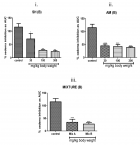Abstract
Research Article
Co-extract mixture from Strophanthus hispidus (roots) and Aframomum meleguta (seeds) show phytochemical synergy in its anti-inflammatory activity
John Kenneth Mensah*, Amina Ibrahim and Yakubu Jibira
Published: 11 December, 2019 | Volume 3 - Issue 1 | Pages: 089-100
Background: Combination of extracts from multiple plants are typically used in ethnomedicine to putatively offer more potent chemotherapeutic and chemopreventive effects than that of individual extracts from single plants. Aqueous extracts from two multipurpose plants Strophanthus hispidus (roots) and Aframomum meleguta (seeds) are topically co-administered in the nasal cavities for the ethnomedicinal management of chronic sinusitis.
Aim: This study assessed the potential phytochemical synergy between constituent extracts of Strophanthus hispidus (roots) and Aframomum meleguta (seeds) in its anti-inflammation, anti-microbial and anti-oxidant effects.
Methods and Materials: Broth dilution assay assessed anti-microbial activities. DPPH radical scavenging assay examined the scope of anti-oxidant activities and inhibition of carrageenan-induced 7-day old chick feet oedema revealed anti-inflammatory activities.
Results: Anti-microbial activities of individual plant extracts in broth dilution assay showed comparable potency to that of the co-extract mixture. Similarly, individual extracts showed levels of DPPH radical scavenging activities in anti-oxidant assay that was comparable to those found for the co-extract mixture. In contrast to these two effects, inhibition of carrageenan-induced 7-day old chick feet oedema revealed an anti-inflammatory activity evoked by co-extract mixtures that was greater than the sum of the individual potencies of the two extracts.
Conclusion: The potential phytochemical synergy of the two plants extracts in its anti-inflammatory response largely validates ethnomedicinal practice and generally confirms growing literature reports that ascribe the net pharmacological activities of herbal extracts to the combined multi-activities of unique phytochemical entities at multiple target sites.
Read Full Article HTML DOI: 10.29328/journal.apps.1001019 Cite this Article Read Full Article PDF
Keywords:
Strophanthus hispidus; Aframomum meleguta; Anti-microbial; Anti-oxidant; Anti-inflammation
References
- Williamson EM. Synergy and other interactions in phytomedicines. Phytomedicine. 2001; 8: 401-409. PubMed: https://www.ncbi.nlm.nih.gov/pubmed/11695885
- Komape NP, Bagla VP, Kabongo-Kayoka P, Masoko P. Anti-mycobacteria potential and synergistic effects of combined crude extracts of selected medicinal plants used by Bapedi traditional healers to treat tuberculosis related symptoms in Limpopo Province, South Africa. BMC Complement Altern Med. 2017; 17: 128-135. PubMed: https://www.ncbi.nlm.nih.gov/pubmed/28235402
- Liu Z, Luo Z, Jia C, Wang D, Li D. Synergistic Effects of Potentilla fruticosa L. Leaves Combined with Green Tea Polyphenols in a Variety of Oxidation Systems. J Food Sci. 2016; 81: 1091-1101. PubMed: https://www.ncbi.nlm.nih.gov/pubmed/27061936
- Ahounou JF, Ouedraogo GG, Gbenou JD, Ouedraogo S, Agbodjogbe WK, et al. Spasmolytic effects of aqueous extract of mixture from Aframomumum melegueta (K Schum) - Citrus aurantifolia (Christm and Panzer) on isolated trachea from rat. Afr J Tradit Complement Altern Med. 2011; 9: 228-233. PubMed: https://www.ncbi.nlm.nih.gov/pubmed/23983339
- Brahmbhatt M, Gundala SR, Asif G, Shamsi SA, Aneja R. Ginger phytochemicals exhibit synergy to inhibit prostate cancer cell proliferation. Nutr Cancer. 2013; 65: 263-272. PubMed: https://www.ncbi.nlm.nih.gov/pubmed/23441614
- Wallig MA, Heinz-Taheny KM, Epps DL, Gossman T. Synergy among phytochemicals within crucifers: does it translate into chemoprotection? J Nutr. 2005; 135: 2972S-2977S. PubMed: https://www.ncbi.nlm.nih.gov/pubmed/16317157
- Fageyinbo MS, Akindele AJ, Adenekan SO, Agbaje EO. Evaluation of in-vitro and in-vivo antidiabetic, antilipidemic and antioxidant potentials of aqueous root extract of Strophanthus hispidus DC (Apocynaceae). J Complement Integr Med. 2019; 16. PubMed: https://www.ncbi.nlm.nih.gov/pubmed/31318693
- Ishola IO, Awodele O, Oreagba IA, Murtala AA, Chijioke MC. Antinociceptive, anti-inflammatory and antiulcerogenic activities of ethanol root extract of Strophanthus hispidus DC (Apocynaceae). J Basic Clin Physiol Pharmacol. 2013; 24: 277-286. PubMed: https://www.ncbi.nlm.nih.gov/pubmed/23729560
- Agyare C, Dwobeng AS, Agyepong N, Boakye YD, Mensah KB, et al. Antimicrobial, Antioxidant, and Wound Healing Properties of Kigelia africana (Lam.) Beneth. and Strophanthus hispidus DC. Adv Pharmacol Sci. 2013; 2013: 692613. PubMed: https://www.ncbi.nlm.nih.gov/pubmed/23662099
- Freiesleben SH, Soelberg J, Jäger AK. Medicinal plants used as excipients in the history in Ghanaian herbal medicine. J Ethnopharmacol. 2015; 174: 561-568. PubMed: https://www.ncbi.nlm.nih.gov/pubmed/25773489
- Ilic NM, Dey M, Poulev AA, Logendra S, Kuhn PE, et al. Anti-inflammatory activity of grains of paradise (Aframomum melegueta Schum) extract. J Agric Food Chem. 2014; 62: 10452-10457. PubMed: https://www.ncbi.nlm.nih.gov/pubmed/25293633
- Onoja SO, Omeh YN, Ezeja MI, Chukwu MN. Evaluation of the in vitroi and in vivo Antioxidant Potentials of Aframomum melegueta Methanolic Seed Extract. J Trop Med. 2014; 2014: 159343. PubMed: https://www.ncbi.nlm.nih.gov/pubmed/24955096
- Abdel-Naim AB, Alghamdi AA, Algandaby MM, Al-Abbasi FA, Al-Abd AM, et al. Phenolics Isolated from Aframomum meleguta Enhance Proliferation and Ossification Markers in Bone Cells. Molecules. 2017; 22. PubMed: https://www.ncbi.nlm.nih.gov/pubmed/28869564
- Mensah JK, Amarh MA. Antioxidant, antimicrobial and anti-inflammation activities of Telfairia occidentalis seeds extract. Current Science Perspectives. 2019; 5: 14-23.
- Trease GE, and Evans WC. Ed. Pharmacology, 12th Edn. Bailliere Tindal Macmillan Publishers: London UK.1984; 257.
- Mensah JK, Golomeke D. Antioxidant and antimicrobial activities of the extracts of the Calyx of Hibiscus Sabdariffa Linn. Current Science Perspectives 2015; 1: 69-76.
- Caesar LK, Cech NB. Synergy and antagonism in natural product extracts: when 1 + 1 does not equal 2. Nat Prod Rep. 2019; 36: 869-888. PubMed: https://www.ncbi.nlm.nih.gov/pubmed/31187844
- Liu RH. Potential synergy of phytochemicals in cancer prevention: mechanism of action. J Nutr. 2004; 134: 3479S-3485S. PubMed: https://www.ncbi.nlm.nih.gov/pubmed/15570057
- Borthakur A, Bhattacharyya S, Anbazhagan AN, Kumar A, Dudeja, PK, et al. Prolongation of carrageenan-induced inflammation in human colonic epithelial cells by activation of an NFκB-BCL10 loop. Biochim Biophys Acta. 2012; 1822: 1300–1307. PubMed: https://www.ncbi.nlm.nih.gov/pubmed/22579587
- Chikara S, Nagaprashantha LD, Singhal J, Horne D, Awasthi S, et al. Oxidative stress and dietary phytochemicals: Role in cancer chemoprevention and treatment. Cancer Lett. 2018; 413: 122-134. PubMed: https://www.ncbi.nlm.nih.gov/pubmed/29113871
- Perumal Samy R, Gopalakrishnakone P. Therapeutic Potential of Plants as Anti-microbials for Drug Discovery. Evid Based Complement Alternat Med. 2010; 7: 283-294. PubMed: https://www.ncbi.nlm.nih.gov/pubmed/18955349
- Lin YT, Labbe RG, Shetty K. Inhibition of Listeria monocytogenes in fish and meat systems by use of oregano and cranberry phytochemical synergies. Appl Environ Microbiol. 2004; 70: 5672-5678. PubMed: https://www.ncbi.nlm.nih.gov/pubmed/15345457
- Lin YT, Kwon YI, Labbe RG, Shetty K. Inhibition of Helicobacter pylori and associated urease by oregano and cranberry phytochemical synergies. Appl Environ Microbiol. 2005; 71: 8558-8564. PubMed: https://www.ncbi.nlm.nih.gov/pubmed/16332847
- Hsieh TC, Wu JM. Suppression of cell proliferation and gene expression by combinatorial synergy of EGCG, resveratrol and gamma-tocotrienol in estrogen receptor-positive MCF-7 breast cancer cells. Int J Oncol. 2008; 33: 851-859. PubMed: https://www.ncbi.nlm.nih.gov/pubmed/18813800
- Vattem DA, Jang HD, Levin R, Shetty K. Synergism Of Cranberry Phenolics With Ellagic Acid And Rosmarinic Acid For Antimutagenic And DNA Protection Functions. J Food Biochemistry. 2006: 30: 98-116.
- Malongane F, McGaw LJ, Mudau FN. The synergistic potential of various teas, herbs and therapeutic drugs in health improvement: a review. J Sci Food Agric. 2017; 97: 4679-4689. PubMed: https://www.ncbi.nlm.nih.gov/pubmed/28585285
- Zhou JR, Yu L, Zhong Y, Blackburn GL. Soy phytochemicals and tea bioactive components synergistically inhibit androgen-sensitive human prostate tumors in mice. J Nutr. 2003; 133: 516-521. PubMed: https://www.ncbi.nlm.nih.gov/pubmed/12566493
- Ayaz M, Ullah F, Sadiq A, Ullah F, Ovais M, et al. Synergistic interactions of phytochemicals with antimicrobial agents: Potential strategy to counteract drug resistance. Chem Biol Interact. 2019; 308: 294-303. PubMed: https://www.ncbi.nlm.nih.gov/pubmed/31158333
- Essid R, Hammami M, Gharbi D, Karkouch I, Hamouda TB, et al. Antifungal mechanism of the combination of Cinnamomum verum and Pelargonium graveolens essential oils with fluconazole against pathogenic Candida strains. Appl Microbiol Biotechnol. 2017; 101: 6993-7006. PubMed: https://www.ncbi.nlm.nih.gov/pubmed/28766033
- Zhang L, Virgous C, Si H. Synergistic anti-inflammatory effects and mechanisms of combined phytochemicals. J Nutr Biochem. 2019; 69: 19-30. PubMed: https://www.ncbi.nlm.nih.gov/pubmed/31048206
Figures:

Figure 1

Figure 2

Figure 3

Figure 4

Figure 5
Similar Articles
-
Co-extract mixture from Strophanthus hispidus (roots) and Aframomum meleguta (seeds) show phytochemical synergy in its anti-inflammatory activityJohn Kenneth Mensah*,Amina Ibrahim,Yakubu Jibira. Co-extract mixture from Strophanthus hispidus (roots) and Aframomum meleguta (seeds) show phytochemical synergy in its anti-inflammatory activity. . 2019 doi: 10.29328/journal.apps.1001019; 3: 089-100
-
Antiuropathogenic and antioxidant activities of Hypoxis hemerocallidea Lam. extracts, and compounds from its taxonomically related speciesKokoette Bassey*,Sekelwa Cosa. Antiuropathogenic and antioxidant activities of Hypoxis hemerocallidea Lam. extracts, and compounds from its taxonomically related species. . 0020 doi: 10.29328/journal.apps.1001020; 4: 001-009
-
In vitro, Anti-oxidant, and Anti-inflammatory Activity of Kalanchoe pinnataWijeratne Mudiyanselage Swarna Menu*. In vitro, Anti-oxidant, and Anti-inflammatory Activity of Kalanchoe pinnata. . 2025 doi: 10.29328/journal.apps.1001064; 9: 001-008
Recently Viewed
-
Navigating Neurodegenerative Disorders: A Comprehensive Review of Current and Emerging Therapies for Neurodegenerative DisordersShashikant Kharat*, Sanjana Mali*, Gayatri Korade, Rakhi Gaykar. Navigating Neurodegenerative Disorders: A Comprehensive Review of Current and Emerging Therapies for Neurodegenerative Disorders. J Neurosci Neurol Disord. 2024: doi: 10.29328/journal.jnnd.1001095; 8: 033-046
-
Metastatic Brain Melanoma: A Rare Case with Review of LiteratureNeha Singh,Gaurav Raj,Akshay Kumar,Deepak Kumar Singh,Shivansh Dixit,Kaustubh Gupta*. Metastatic Brain Melanoma: A Rare Case with Review of Literature. J Radiol Oncol. 2025: doi: 10.29328/journal.jro.1001080; 9: 050-053
-
Validation of Prognostic Scores for Attempted Vaginal Delivery in Scar UterusMouiman Soukaina*,Mourran Oumaima,Etber Amina,Zeraidi Najia,Slaoui Aziz,Baydada Aziz. Validation of Prognostic Scores for Attempted Vaginal Delivery in Scar Uterus. Clin J Obstet Gynecol. 2025: doi: 10.29328/journal.cjog.1001185; 8: 023-029
-
Scientific Analysis of Eucharistic Miracles: Importance of a Standardization in EvaluationKelly Kearse*,Frank Ligaj. Scientific Analysis of Eucharistic Miracles: Importance of a Standardization in Evaluation. J Forensic Sci Res. 2024: doi: 10.29328/journal.jfsr.1001068; 8: 078-088
-
A study of coagulation profile in patients with cancer in a tertiary care hospitalGaurav Khichariya,Manjula K*,Subhashish Das,Kalyani R. A study of coagulation profile in patients with cancer in a tertiary care hospital. J Hematol Clin Res. 2021: doi: 10.29328/journal.jhcr.1001015; 5: 001-003
Most Viewed
-
Evaluation of Biostimulants Based on Recovered Protein Hydrolysates from Animal By-products as Plant Growth EnhancersH Pérez-Aguilar*, M Lacruz-Asaro, F Arán-Ais. Evaluation of Biostimulants Based on Recovered Protein Hydrolysates from Animal By-products as Plant Growth Enhancers. J Plant Sci Phytopathol. 2023 doi: 10.29328/journal.jpsp.1001104; 7: 042-047
-
Sinonasal Myxoma Extending into the Orbit in a 4-Year Old: A Case PresentationJulian A Purrinos*, Ramzi Younis. Sinonasal Myxoma Extending into the Orbit in a 4-Year Old: A Case Presentation. Arch Case Rep. 2024 doi: 10.29328/journal.acr.1001099; 8: 075-077
-
Feasibility study of magnetic sensing for detecting single-neuron action potentialsDenis Tonini,Kai Wu,Renata Saha,Jian-Ping Wang*. Feasibility study of magnetic sensing for detecting single-neuron action potentials. Ann Biomed Sci Eng. 2022 doi: 10.29328/journal.abse.1001018; 6: 019-029
-
Pediatric Dysgerminoma: Unveiling a Rare Ovarian TumorFaten Limaiem*, Khalil Saffar, Ahmed Halouani. Pediatric Dysgerminoma: Unveiling a Rare Ovarian Tumor. Arch Case Rep. 2024 doi: 10.29328/journal.acr.1001087; 8: 010-013
-
Physical activity can change the physiological and psychological circumstances during COVID-19 pandemic: A narrative reviewKhashayar Maroufi*. Physical activity can change the physiological and psychological circumstances during COVID-19 pandemic: A narrative review. J Sports Med Ther. 2021 doi: 10.29328/journal.jsmt.1001051; 6: 001-007

HSPI: We're glad you're here. Please click "create a new Query" if you are a new visitor to our website and need further information from us.
If you are already a member of our network and need to keep track of any developments regarding a question you have already submitted, click "take me to my Query."



















































































































































